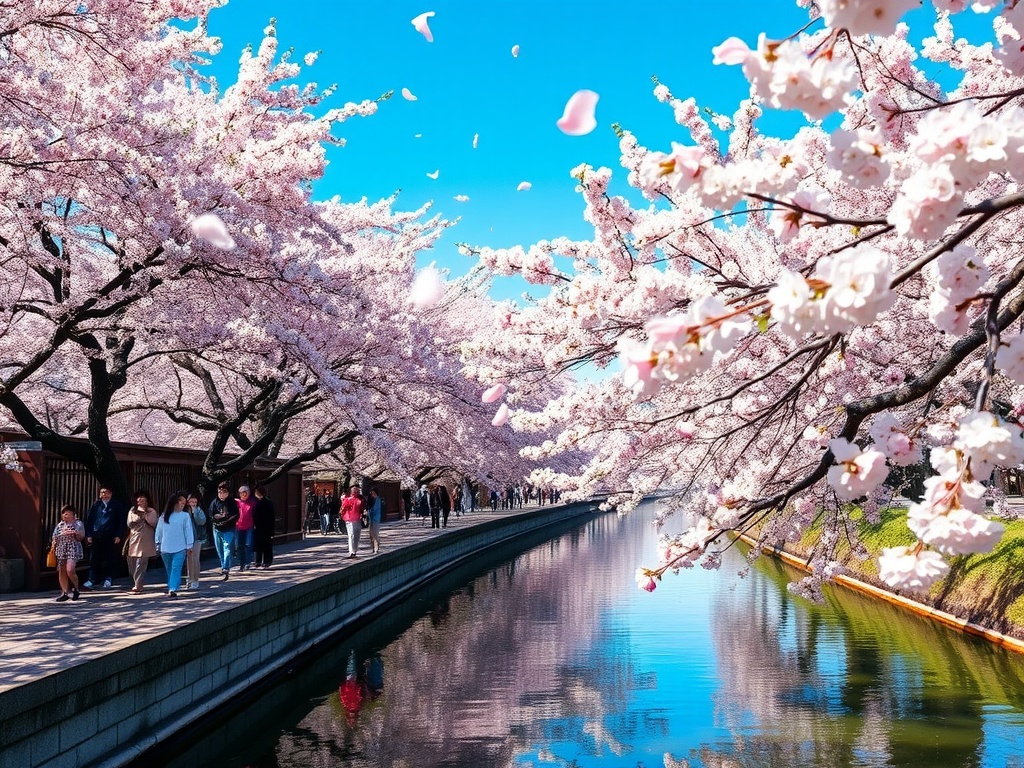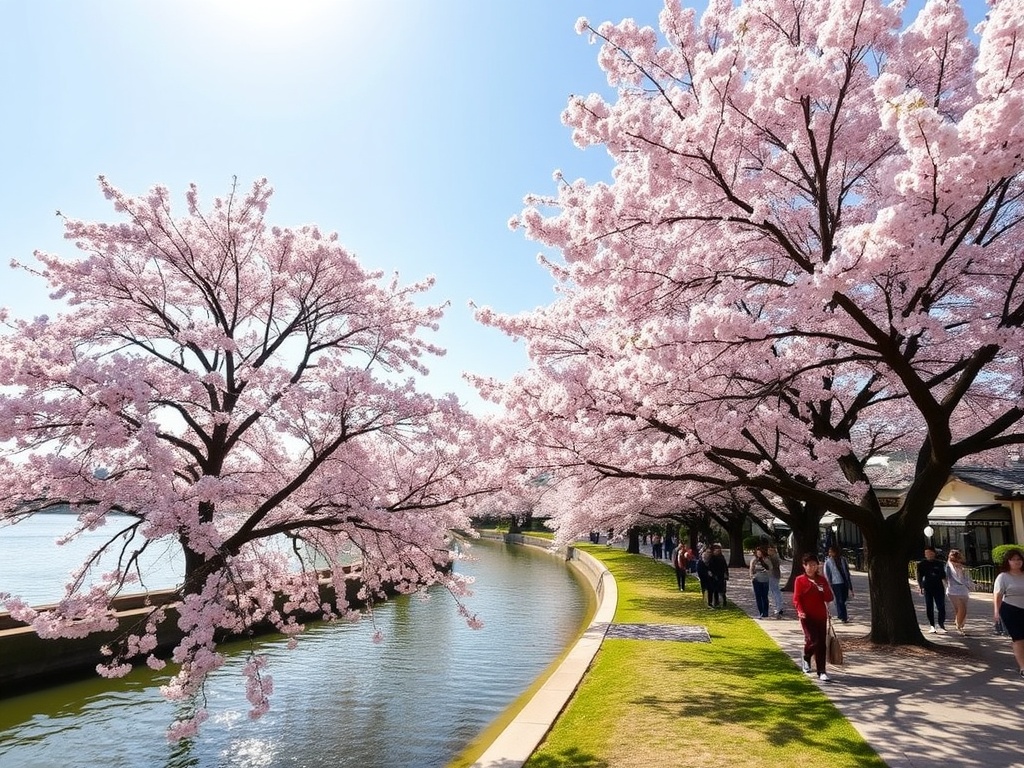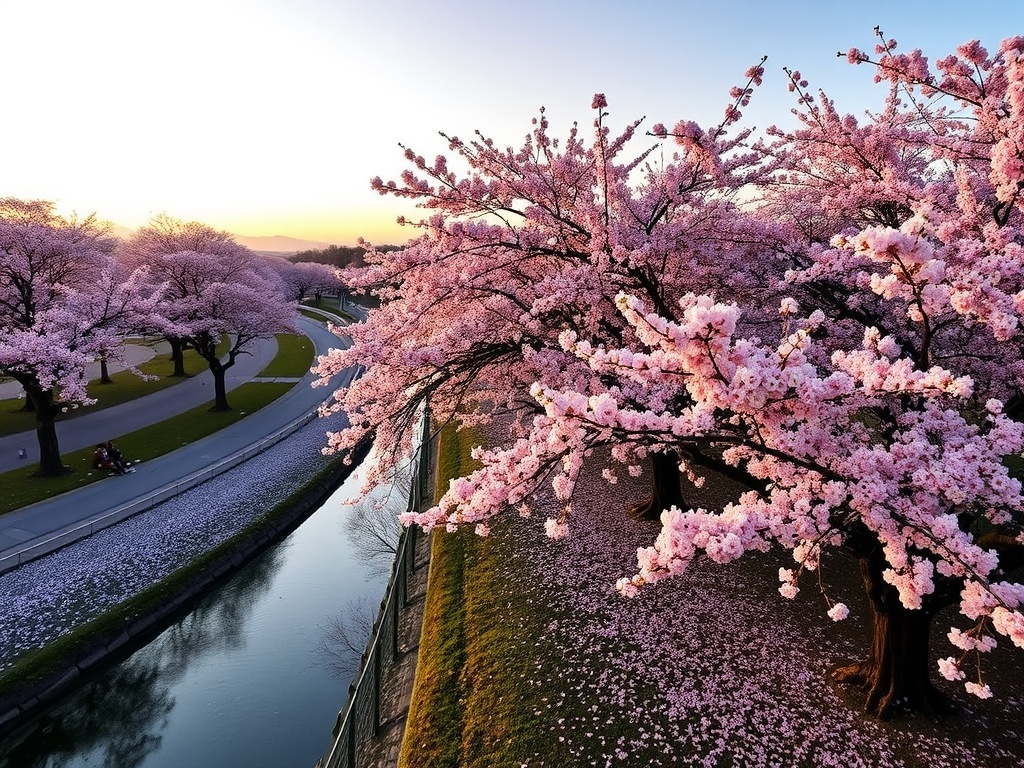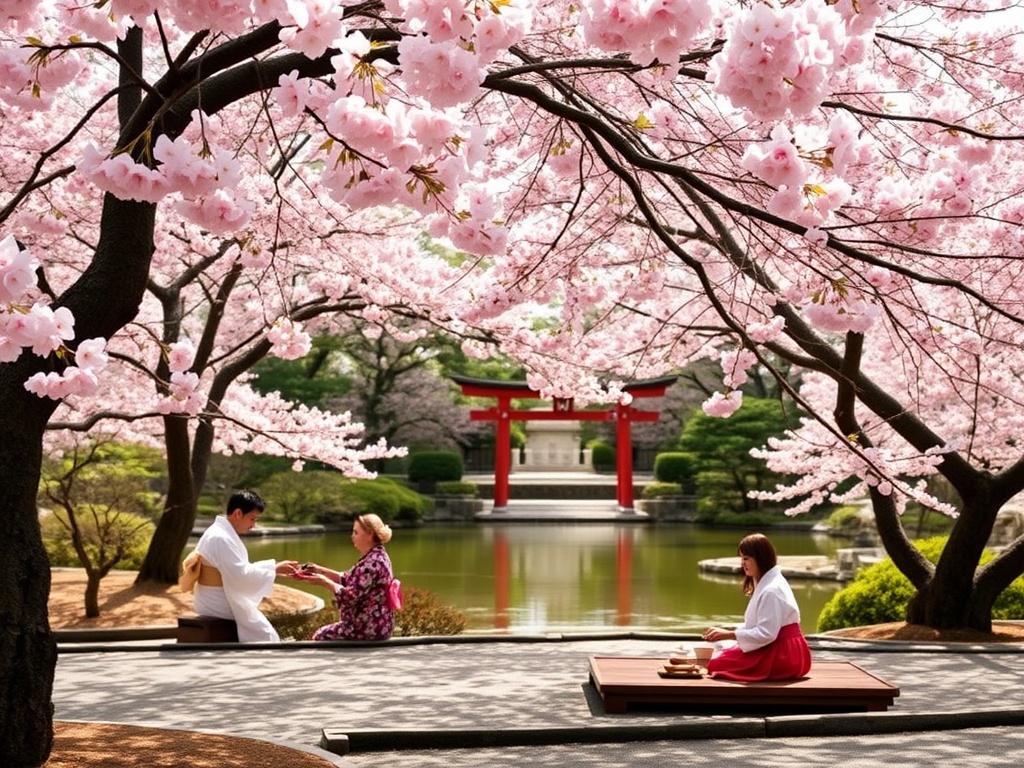Cherry Blossom Chronicles: Timing Your Visit for Peak Blooms
Win a Free Trip to Japan!
Experience cherry blossoms and ancient temples
Every spring, a vibrant tapestry of pink and white petals transforms Japan into a romantic wonderland, drawing tourists from around the globe. This natural phenomenon, known as ‘sakura’ or cherry blossom season, is a fleeting spectacle that requires precise timing to experience at its peak. Embark on a journey through the ‘Cherry Blossom Chronicles,’ as we guide you in planning your visit to witness this enchanting bloom.
The cherry blossom season, though short-lived, varies across regions in Japan. Typically starting in the southern islands in late January and reaching the northernmost parts by early May, the bloom period lasts for about a week in each area. To help you plan your trip, here’s a table outlining the average blooming periods in popular locations:
| Location | Average Start of Bloom | Peak Bloom Period |
|---|---|---|
| Okinawa | Late January | Early February |
| Kyoto | Late March | Early April |
| Tokyo | Late March | Early April |
| Sapporo | Late April | Early May |
While the entire country is bedecked with sakura, certain locations provide an extraordinary backdrop. Here are some top cherry blossom viewing spots that promise an unforgettable experience:
- Ueno Park, Tokyo: Known for its lively atmosphere, Ueno Park hosts over a thousand cherry trees, making it a favorite spot for hanami, or flower viewing parties.
- Maruyama Park, Kyoto: This park offers a serene setting with a magnificent weeping cherry tree that becomes a focal point for photographers and nature lovers alike.
- Himeji Castle, Himeji: The contrast of the white castle against the pink blooms is a sight to behold, offering a glimpse into Japan’s rich history along with its natural beauty.
Timing your visit for peak blooms is crucial, but so is making the most of your sakura experience. Here are some tips to enhance your cherry blossom journey:
- Check Bloom Forecasts: Keep an eye on sakura forecasts as your travel date approaches. These forecasts provide updates on bloom progression across various regions.
- Embrace the Culture: Participate in hanami by enjoying a picnic under the cherry trees, a cherished tradition among locals and tourists alike.
- Capture the Moment: Don’t forget your camera! Early morning or late afternoon light offers the best conditions for capturing the delicate beauty of sakura.
Hanami Hotspots: Discover the Most Enchanting Sakura Locations
Japan’s cherry blossom season, known as sakura, is a breathtaking event that transforms landscapes into a sea of pink and white. As you plan your journey to witness this natural spectacle, you’ll want to know the most enchanting locations for experiencing hanami—the cherished tradition of flower viewing. With each region offering its unique charm, these destinations are guaranteed to leave a lasting impression on your travel memories.
Shinjuku Gyoen National Garden in Tokyo is a must-visit for any sakura enthusiast. This sprawling garden offers a blend of traditional Japanese, formal French, and English landscape gardens, providing diverse vistas of cherry blossoms. The tranquil atmosphere is perfect for those seeking a peaceful hanami experience amidst the city bustle.
Heading to the historic city of Nara, Nara Park presents an extraordinary setting where deer roam freely among the blooming cherry trees. The combination of wildlife and blossoms creates an enchanting atmosphere, reminiscent of Japan’s ancient tales. This unique interaction between nature and history makes Nara Park a standout among hanami hotspots.
While the cherry blossoms are the main attraction, part of the magic lies in embracing the local culture. In Hirosaki, Aomori Prefecture, the famous Hirosaki Castle Park not only offers stunning sakura views but also hosts a lively cherry blossom festival. Visitors can enjoy traditional food stalls, live performances, and even night-time illuminations that cast a magical glow over the blossoms.
For those venturing into the Kansai region, Osaka Castle Park provides another captivating hanami experience. The park’s wide grounds are perfect for picnicking under the cherry trees, and the juxtaposition of the historic castle with the vibrant blooms reflects Japan’s ability to harmonize its rich history with natural beauty. Engaging with locals during these gatherings adds an authentic touch to your sakura journey.
Cultural Revelations: Traditions and Tales of Sakura Season
As the cherry blossoms scatter their delicate petals across Japan, they weave a rich tapestry of cultural traditions and stories that have been cherished for centuries. Beyond their stunning visual appeal, sakura blooms are deeply intertwined with the nation’s identity, symbolizing the ephemeral beauty of life, renewal, and the arrival of spring. For travelers and enthusiasts, understanding these cultural nuances enhances the sakura experience, offering a deeper connection to Japan’s historical and spiritual tapestry.
The tradition of hanami, or flower viewing, dates back over a thousand years to the Nara period, where it began as an exclusive practice for the elite. During the Heian era, it evolved into a popular pastime, celebrated through poetry and art. Today, hanami is a universal celebration, inviting people from all walks of life to gather under the cherry trees, reflecting on the transient nature of life. This deep-rooted practice not only highlights Japan’s appreciation for nature but also emphasizes the cultural importance of community and togetherness.
Embedded within the petals of the sakura are tales and legends that have been passed down through generations. One such story tells of the goddess Konohanasakuya-hime, often associated with cherry blossoms, who is said to bring prosperity and good fortune. Her story is celebrated in various festivals across the country, where traditional dances and rituals honor her legacy. These narratives, rich in symbolism and folklore, provide travelers with a unique lens through which to view the blossoms, adding layers of meaning to their vibrant beauty.
Engaging with these cultural revelations allows visitors to not only witness the breathtaking spectacle of sakura but also to partake in the living history and traditions that continue to shape Japan’s cultural landscape. Whether you’re sharing a picnic under the blossoms or learning about ancient myths, the sakura season offers an immersive experience that resonates long after the petals have fallen.
Capturing Petal Perfection: Photography Tips for Sakura Enthusiasts
Every spring, photographers from around the world flock to Japan, eager to capture the ethereal beauty of the sakura blossoms. These delicate blooms offer a fleeting opportunity to create stunning visuals that tell the story of nature’s grace. Whether you’re a seasoned photographer or an amateur enthusiast, capturing the essence of cherry blossoms requires a blend of technique, creativity, and respect for the environment.
Light plays a crucial role in photography, and sakura blossoms are no exception. The soft, diffused light during the golden hours—shortly after sunrise and just before sunset—provides an ideal setting for capturing the delicate hues of the petals. During these times, the light casts a warm glow that enhances the pinks and whites of the blossoms, offering a magical quality to your photos.
Tip: Overcast days can also be beneficial as the even lighting helps to avoid harsh shadows, allowing for detailed close-ups of individual blossoms.
While wide shots of cherry blossom-laden landscapes are breathtaking, don’t shy away from exploring different perspectives. Try getting up close to focus on the intricate details of a single bloom or capture the contrast between the blossoms and traditional Japanese architecture. Experiment with angles and compositions to create unique and dynamic images that stand out.
- Ideas for Unique Shots:
- Reflection Shots: Utilize nearby water bodies to capture reflections of the blossoms, adding depth to your images.
- Motion Blur: Introduce a sense of movement by capturing falling petals with a slower shutter speed.
- Silhouettes: Use the setting sun to create striking silhouettes against the colorful sky.
While it is tempting to get the perfect shot, it is vital to remember the importance of being respectful to both the natural environment and other visitors. Refrain from picking the blossoms or stepping off designated paths, and ensure you leave no trace behind. By doing so, you help preserve the beauty of the sakura for future generations to enjoy.
With these tips in mind, your journey to photograph Japan’s cherry blossoms can be as rewarding as it is visually stunning, capturing not just the image, but the spirit of sakura season.
Beyond the Blossoms: Exploring Local Festivities and Cuisine
As the sakura petals unfurl in a breathtaking display, the cherry blossom season in Japan becomes more than just a visual feast. It is an invitation to delve into the vibrant tapestry of local festivals and culinary delights that accompany this enchanting period. Embrace the full spectrum of sakura season by immersing yourself in the rich cultural experiences that lie beyond the blooms.
During sakura season, Japan comes alive with festivals that celebrate the arrival of spring. One iconic event is the Hanami Festival, a cherished tradition where locals and tourists gather under the cherry trees for picnics and revelry. In cities like Kyoto and Tokyo, these gatherings are often accompanied by traditional music and dance performances, providing a captivating glimpse into Japan’s cultural heritage.
Another highlight is the Takayama Spring Festival, held in the picturesque town of Takayama. This festival features intricately decorated floats, known as yatai, that parade through the streets as part of a centuries-old tradition. The combination of historical pageantry and the stunning backdrop of cherry blossoms makes this event a must-see for any traveler.
Beyond the visual spectacle, sakura season offers a unique culinary experience. Many regions showcase seasonal specialties that incorporate cherry blossoms and leaves. One such delicacy is Sakura Mochi, a sweet rice cake filled with red bean paste and wrapped in a pickled cherry leaf, offering a harmonious blend of flavors and textures.
In addition to traditional sweets, sakura-themed beverages also make an appearance. Enjoy a cup of sakura tea, where cherry blossoms are steeped in hot water, releasing their subtle fragrance and flavor. For a more indulgent experience, try sakura-infused sake, which adds a floral twist to Japan’s famous rice wine.
Exploring the local festivities and cuisine during sakura season not only enriches your travel experience but also offers a deeper understanding of the cultural significance and traditions that surround this fleeting yet unforgettable time of year.
Sakura Science: Understanding the Phenomenon of Cherry Blossoms
Spring in Japan brings with it a mystical transformation as the landscape bursts into a sea of pink and white, heralding the much-anticipated sakura season. This natural wonder, captivating and ephemeral, is not just a feast for the eyes but also a fascinating biological event shaped by a complex interplay of environmental factors and botanical intricacies. For those keen on understanding the science behind this fleeting spectacle, we delve into the mysteries of cherry blossoms—a phenomenon that continues to enchant generations.
The sakura trees, with their delicate beauty, are primarily driven by the rhythm of nature. The timing of their bloom is dictated by a combination of factors including temperature fluctuations, daylight hours, and geographical location. As winter’s chill fades, rising temperatures signal the trees to awaken from dormancy. This triggers a biological process that leads to the emergence of buds, eventually unfurling into the iconic blossoms. Interestingly, the timing of this process can vary significantly across Japan, influenced by each region’s unique climate and weather patterns.
For instance, the southern areas like Okinawa experience their bloom much earlier compared to the northern regions such as Hokkaido. This gradual northward progression of blooms creates a wave of pink that sweeps across the country, offering multiple opportunities for travelers to witness this magical event. Understanding these regional differences is crucial for planning the perfect sakura-themed journey.
While the sakura’s blooming schedule is largely driven by climate, unexpected weather changes can greatly impact the timing and duration of the bloom. A sudden cold snap or an early warm spell can accelerate or delay the blossoming period, respectively. Research has shown that even minor variations in temperature can significantly affect the flowering process, highlighting the delicate balance these trees maintain with their environment.
Moreover, rainfall and wind play pivotal roles during the bloom. While rain can enhance the vivid colors of the blossoms, excessive rain or strong winds may shorten the viewing season by causing petals to fall prematurely. This delicate interplay between the elements and the blossoms underscores the transient nature of sakura, making each year’s bloom a unique experience.
By appreciating the scientific intricacies behind the sakura bloom, travelers can gain a deeper understanding of this natural wonder, enhancing their overall experience of Japan’s cherished cherry blossom season.



